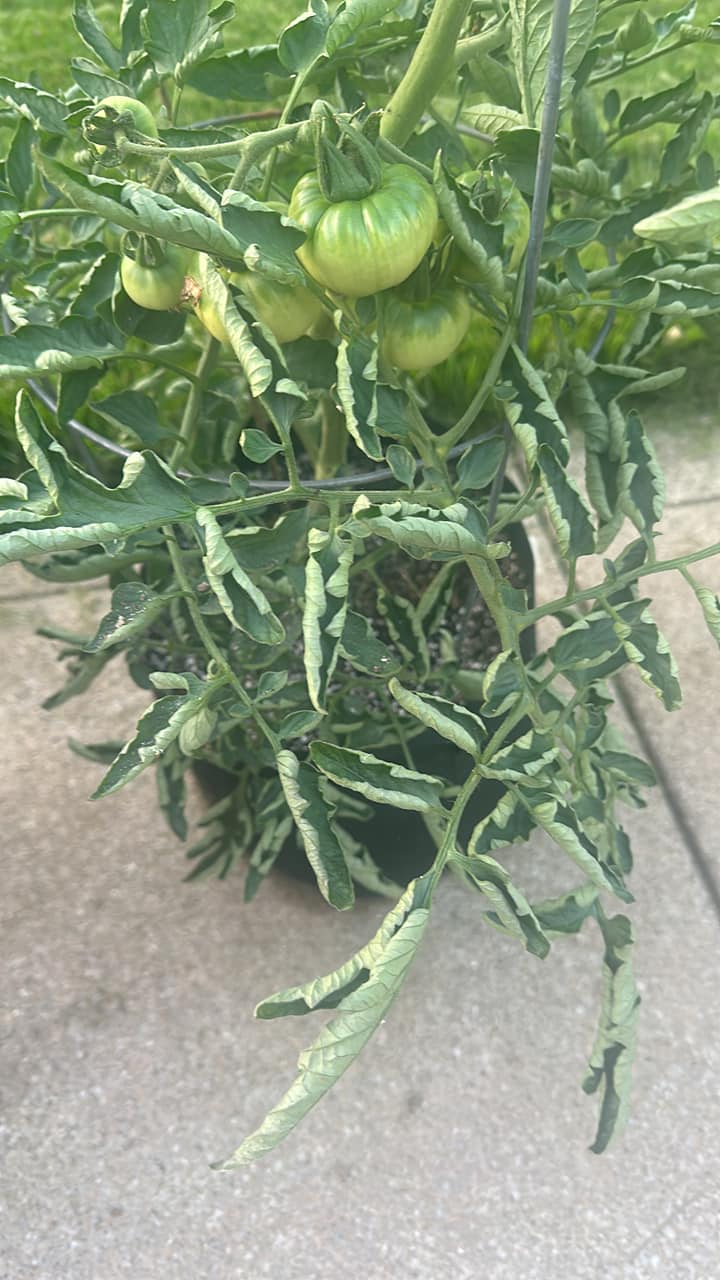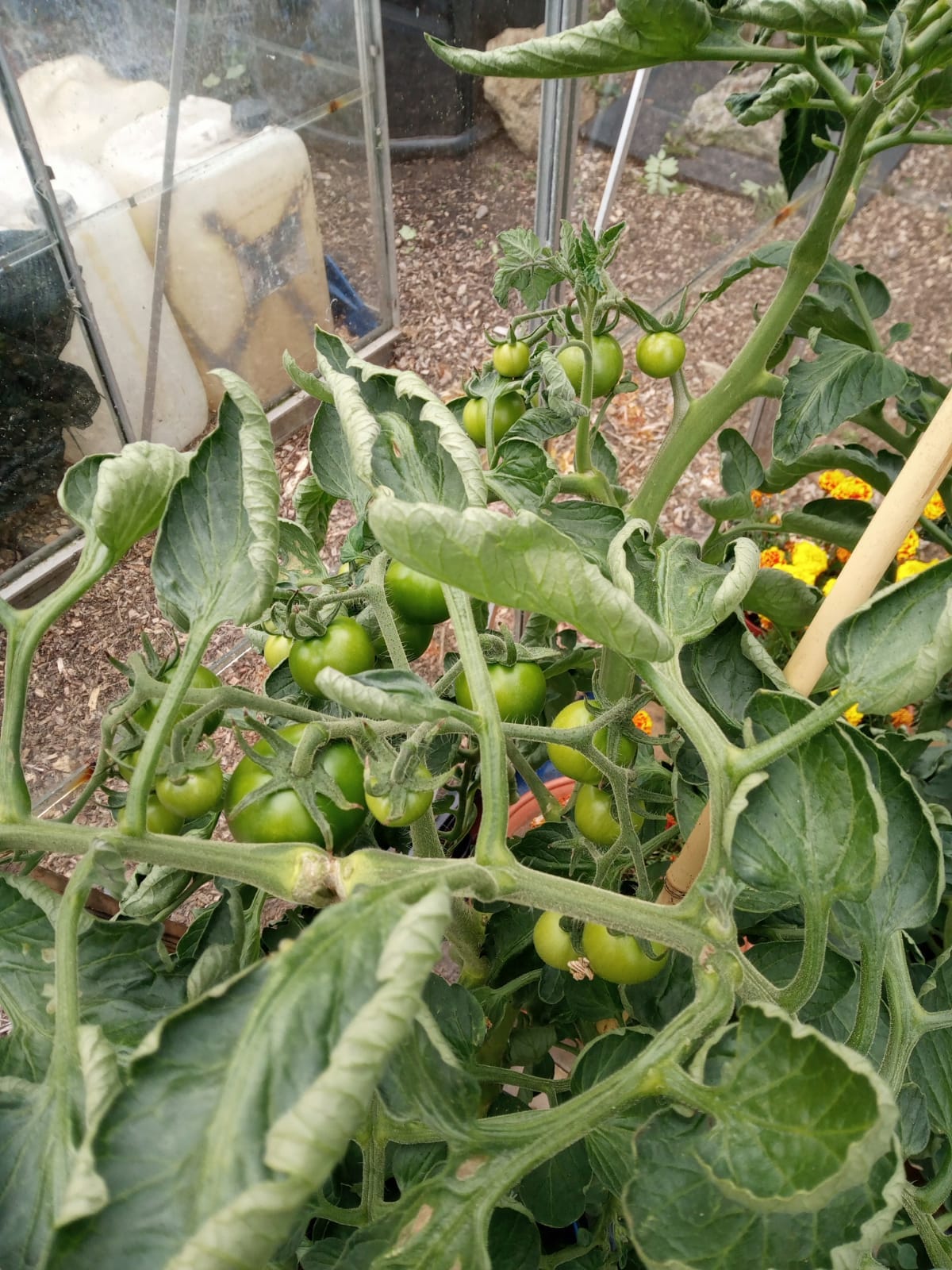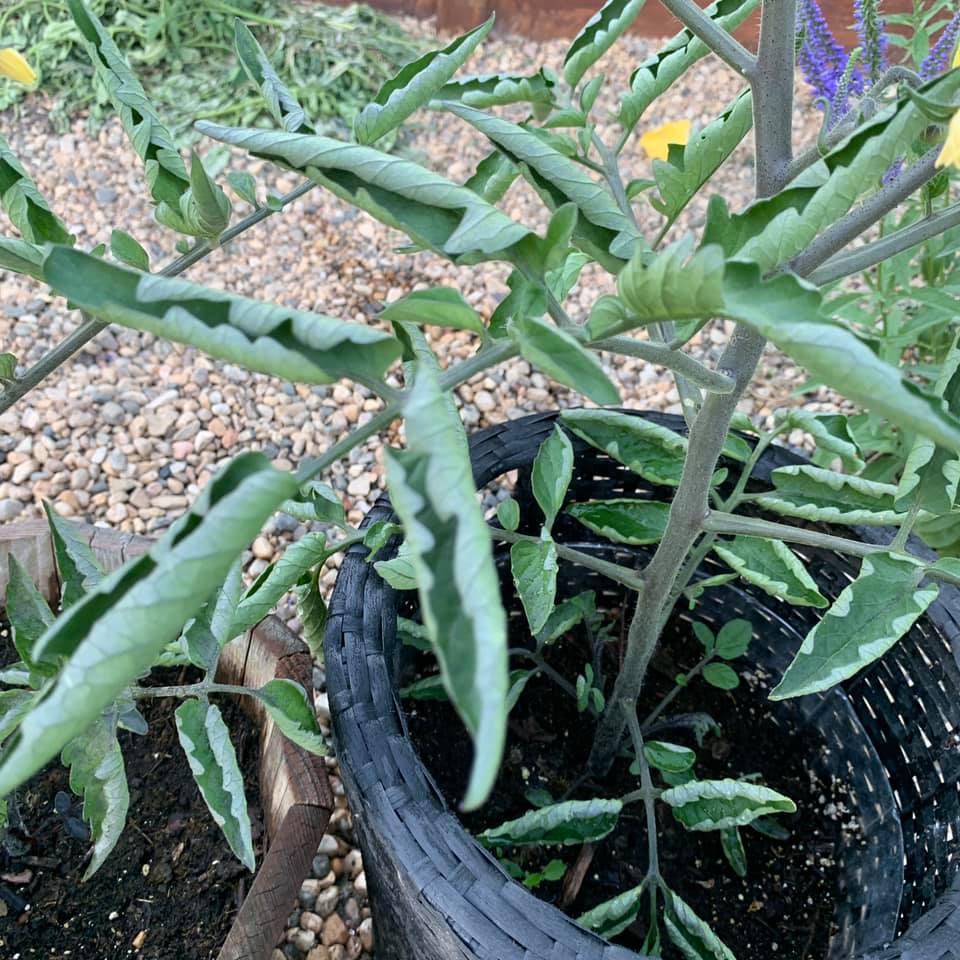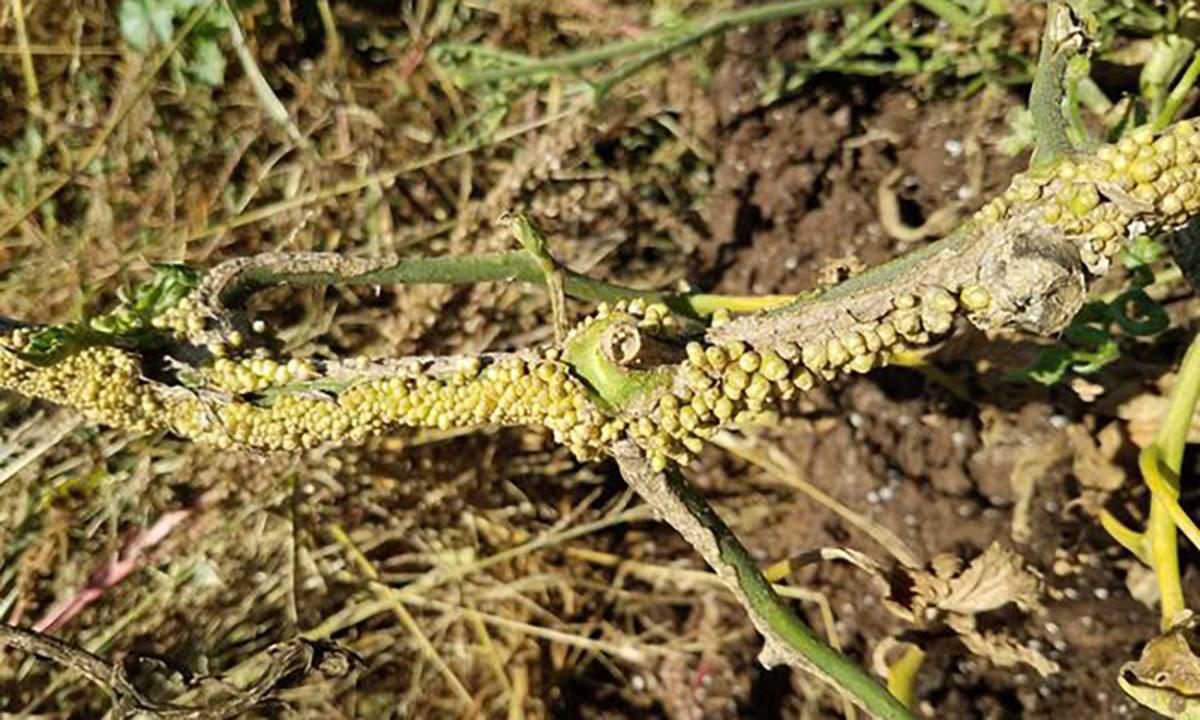
Seeing the leaves on your potted tomato plant leaves curling and distorting is cause for concern. Leaf curl can indicate serious underlying issues that will compromise plant growth and fruit production if left unchecked. Don’t let it progress – with prompt troubleshooting and solutions, you can get your container tomatoes back on track. This comprehensive guide covers all the common causes of potted tomato leaves curling and provides organic methods to restore your plants to health. Remediate any problems now before they escalate and you can still harvest robust yields from vibrant tomato plants this season.
This post may have affiliate links. This means that sometimes when you click a link on our site and make a purchase on Amazon, we may earn a small commission at no additional cost to you. We only recommend products we truly believe in, and your support helps keep us running!
Table of Contents
Diagnosing Potential Causes of Potted Tomato Leaves Curling

Properly identifying the trigger behind the leaf curl is crucial for knowing how to fix it. Here are the most common causes to investigate:
Insufficient water
Drooping, curled leaves with dry soil indicate under-watering. Tomato plants need a thorough deep watering at soil level once a week in containers. Drought stress causes the foliage to wilt and curl upward. Consistently monitor soil moisture 2-3 inches down and water again before it fully dries out.
Over-watering
If lower leaves are curled downward and soil stays soggy and wet for too long, overwatering tomato plants could be the issue. Allow more drying time in between waterings to prevent waterlogged roots. Tomato roots need oxygen too. Leaves yellow and curl with too much water. Space out deep waterings to once the top few inches become partly dry. Improve drainage by amending soil.
High winds
Tomato plants in exposed areas can develop tightly curled leaves and stunted growth as the constant wind buffets and desiccates foliage. To protect plants, move containers to a sheltered location or install temporary windbreaks using stakes, netting, burlap or privacy fencing panels around the tomatoes to create a calm microclimate. Also ensure plants have sufficient moisture when winds increase.
Sunscald

If tomato leaf margins are tightly curling upward away from intense sunlight, the foliage may be suffering from sunscald damage. On very hot days, afternoon sun can overheat plants. Solutions include providing shade cloths, moving containers to only morning sun locations, or spraying leaves daily with water to lower their temperature during peak heat hours.
Root damage
Both transplant shock and tangled circular roots in root-bound containers can damage tomato roots, causing foliage to curl and wilt. Carefully remove plants from containers to avoid root breakage and tease apart any circled roots before re-planting in larger containers. Prune off damaged roots. Water gently until established again.
Pest infestations
Curled and distorted tomato leaves often indicate sap-sucking insect pests like aphids, whiteflies, leafhoppers or spider mites. Check the undersides of curled leaves closely for tiny bugs. Remove pests with strong blasts of water, insecticidal soap or neem oil applications. Control infestations quickly before widespread damage occurs.
Herbicide damage

The emergence of extra roots along the stems of plants is an additional indication of being exposed to herbicides. Drift or overspray from common lawn weed killers containing 2,4-D or dicamba can cause tomato leaf curling, twisting and stunting. Keep tomatoes protected and covered when applying chemicals nearby. Wash plants after suspected drift incidents. Avoid volatile formulations prone to traveling.
Disease
Some foliar tomato diseases like leaf mold, bacterial spot, early blight and septoria leaf spot can initially distort and curl leaves. Isolate affected plants immediately and improve airflow. Remove diseased areas and apply approved fungicides to protect healthy tissue if severe.
Closely inspect all parts of affected plants and growing conditions to hone in on what factors may be inducing leaf curl. Matching symptoms to causes is the first step toward a cure.
Reviving Potted Tomato Leaves Curling
Providing Consistent Moisture for Tomato Plants
Irregular watering is one of the most prevalent triggers for potted tomato leaf curl. Tomato plants need thorough weekly watering to support vigorous growth. Here are some suggestions for optimizing tomato plant moisture:
- Water at the base of plants to keep foliage dry and prevent disease. Target the root zone.
- Deeply water until excess drains from container bottoms. Shallow watering encourages shallow roots.
- Allow soil to partially dry out between waterings to maintain a balance of moisture and oxygen to roots.
- Check soil moisture 2-3 inches down before watering again. Don’t rely on surface dryness.
- Add mulch over container soil to significantly slow moisture loss.
- Lifting containers occasionally can prevent roots from escaping and drying out.
- Group pots together to create a more stable, humid microclimate.
- Utilize self-watering containers or drip irrigation lines when traveling.
Figuring out the right rhythm and amount of watering is critical to keeping container tomatoes hydrated just right and their leaves flat and healthy.
Feeding Plants Properly to Avoid Nutrient Deficiencies
Along with consistent water, tomato plants also require adequate nutrition to avoid stress and leaf issues. Fertilize container tomatoes with these organic options:
- At planting, mix slow-release organic tomato fertilizer into soil for 2-3 months of nutrients.
- Every 2-3 weeks during the growing season, feed plants fish emulsion, compost tea, kelp extract or all-purpose organic veggie booster.
- Alternate between water-soluble fertilizers for quick uptake and longer-lasting granular fertilizers.
- Periodically work worm castings, alfalfa meal, or compost into topsoil for an extra nutrient boost.
- Spray foliage with compost tea or seaweed extract for added micronutrients.
- Prevent blossom end rot with biweekly calcium sprays – like eggshell tea.
Proper fertilization ensures tomato plants have the essential macro- and micronutrients to support healthy foliage and fruits. But don’t overdo it, as excess nitrogen leads to all leaf growth with few blooms.
Protecting Plants from Intense Wind
Tomato plants in exposed, windy locations can develop curling leaves and stunted growth as the buffeting damages leaves and depletes moisture reserves. Defend plants against wind with these tactics:
- Position containers beside a building, wall, or solid fencing to block prevailing winds. This creates a calm, sheltered microclimate.
- Install temporary windbreaks around potted tomatoes using stakes and burlap, shade cloth, or privacy slats.
- Surround smaller pots with plastic bottles filled with water to block wind, absorb heat, and elevate humidity.
- Bump up the calcium and boron in container soil – these nutrients strengthen cell walls against wind damage.
- Avoid areas with channelized wind acceleration, like rooftops or gaps between buildings.
Moderating wind exposure keeps tomato foliage healthy and flat rather than dried and distorted by unrelenting wind forces.
Adjusting Sun Exposure to Prevent Sunscald
If tomato leaf margins are curling upward away from sunlight, the foliage may be suffering from sunscald damage. Intense afternoon sun can overheat plants. Solutions include:
- Providing afternoon shade cloth, patio umbrellas, or situating containers on east sides of structures.
- Choosing heat tolerant tomato varieties better adapted to withstand intense sunlight.
- Spraying plants daily with cool water before peak heat hours to lower leaf temperature.
- Applying protective anti-transpirant sprays like Wilt-Pruf® that reduce leaf water loss.
- Whitewashing greenhouses or cold frame lids with lime wash to reflect heat while allowing light.
- Marking sure plants have sufficient water and nutrition to tolerate heat stress.
Modifying sunlight exposure keeps container tomato leaves from excessively curling when sunlight intensity overwhelms the plant.
Fixing Root Problems Causing Foliage Distress
One hidden cause of potted tomato leaf curling is damaged roots struggling to take up moisture and nutrition. Root issues arise from:
- Rough handling during transplanting – carefully remove seedlings to keep roots intact.
- Root-bound containers – roots choke each other once filling a container. Transplant plants into larger pots.
- Root exposure – heat/wind dry exposed escaping roots. Push roots back into soil or use larger pots.
- Root diseases – Overwatering invites root rot diseases. Allow soil to dry out between waterings.
- Excess fertilizer – Too much nutrient salts burns roots. Flush soil and resume balanced feeding.
Healthy roots = healthy productive plants. Care for roots carefully to prevent leaf stress and curling.
Eliminating Pest Infestations
Another common but easily missed cause of curling tomato leaves is sap-sucking pests like aphids, whiteflies, or spider mites. Check the undersides of curled leaves for tiny pests. Remove them organically with:
Strong blasts of water to dislodge insects from leaves.
- Use a moderate pressure stream of water from a hose sprayer to physically knock off and rinse away pests like aphids from plant foliage.
- Focus on the undersides of leaves and areas with heavy infestations. Repeat blasts every few days to disrupt pest colonization before they multiply.
Sprays of neem oil or insecticidal soap to suffocate pests.
- Apply commercial natural pest control products containing neem oil or potassium salts of fatty acids to suffocate soft-bodied insects on contact.
- Coat all leaf surfaces with spray, including undersides, for thorough coverage. Can add a small amount of liquid dish soap to help coat insects.
Releasing predatory beneficial insects like ladybugs or lacewings that consume pests.
- Purchase live ladybugs, lacewings, or other predatory insects from garden stores and release onto affected plants. The predators will eat problematic pests.
- Make releases in the morning or evening to prevent predators from immediately flying away. Mist plants to give them water.
Removing badly infested leaves and spraying plant with a garlic-pepper tea foliar spray.
- Prune off and discard leaves and stems with heavy concentrations of pests to quickly reduce populations. This limits breeding.
- Make an organic repellent spray by steeping crushed garlic and hot peppers overnight in water. Strain and spray onto plants.
Applying diatomaceous earth on and below leaves to shred insect bodies.
- Spread food-grade diatomaceous earth onto leaves and soil. The sharp particles physically cut into soft pest bodies, absorbing oils and causing dehydration/death.
- Reapply after rain or heavy watering which washes away the diatomaceous earth. Wear a mask to avoid inhaling dust.
Addressing insect infestations quickly is key to preventing lasting plant damage and curled, stunted growth.
Preventing Herbicide Injury
Drift or overspray from lawn weed killers like 2,4-D and dicamba can curl potted tomato leaves and lead to leaf drop or distorted new growth. Guard plants by:
Moving container tomatoes away when applying chemicals in nearby yards. Cover plants during application.
- Check wind forecasts before spraying lawns or gardens, and move potted tomatoes upwind or even indoors during application to prevent chemical drift reaching plants.
- Alternatively, completely cover containers with plastic sheeting, tarps or cardboard boxes during nearby spraying to block contact.
Washing plants after any suspected herbicide drift to dilute residue before it penetrates.
- If tomato plants may have been exposed to drifting lawn chemicals, thoroughly wash or rinse the foliage, stems and soil surface to dilute any residues before they can be absorbed by the plant.
- Use a moderate pressure stream of water and rinse the entire plant, including undersides of leaves. Rinsing shortly after exposure can prevent damage.
Raising container heights so they are above lawn level – less risk of being sprayed.
- Situate potted tomatoes on elevated surfaces like tables, stands or pedestals so they sit well above ground level and are less likely to be accidentally sprayed during lawn chemical applications.
- This protects the lower foliage and creates more separation between plants and any chemical use at ground level around them.
Shielding plants with temporary fencing, tarps or plastic sheeting when chemicals are used in vicinity.
- Erect temporary barriers around potted tomatoes using stakes and tarps, plastic sheeting or removable fencing panels to completely block contact with nearby herbicide sprays.
- Make sure to seal off any gaps and fully enclose plants before spraying begins in the area. Leave covered until any drift settles.
Choosing lawn products carefully and avoiding volatile formulations prone to drift in windy conditions.
- Opt for low-volatility herbicide formulations that are less likely to vaporize and drift in windy conditions when spraying near container tomatoes.
- Avoid ester forms of chemicals like 2,4-D ester, which drift more readily. Instead choose amine formations that adhere better to target weeds.
- Spray when winds are very low, ideally early mornings, to minimize chances of chemical drift travelling and reaching tomato plants.
Avoiding inadvertent herbicide damage ensures tomato leaves remain strong and flat, not misshapen from unwanted chemical exposure.
Treating Foliar Disease Issues
If tomato leaf curling is accompanied by spots, scorching or yellowed areas, the cause may be a foliar disease like leaf mold or bacterial spot. Treat disease outbreaks by:
- Removing and destroying badly infected leaves to prevent disease spread.
- Improving airflow by spacing containers further apart and thinning dense growth.
- Watering at the base of plants rather than wetting foliage.
- Applying approved fungicides for tomatoes after inspecting labels for container use safety.
- Extending time between waterings slightly to reduce foliage moisture.
- Planting disease-resistant varieties labeled VFN, VFFNT.
